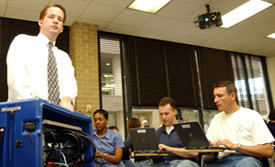|
Feb. 3, 2005
Behind the Scenes, Improving the Internet
A Group of More Than 200 Universities is Working to Build a Faster, More Reliable, and More Secure Internet
By Matt Lindsay
In the fall of 1969 researchers at the University of California-Los Angeles began making tangible progress toward their goal of finding a new method to share data between computers. In September researchers sent data through a 15-foot cable between two computers in a lab, and only a month later professors from UCLA were able to send a message between the Los Angeles university and the Stanford Research Institute. The first message was meant to be “Log in,” and even though the researchers were only able to send “L-o” before the system crashed, the Internet was born.
 In 1969 it was hard to imagine how pervasive this new technology would become. What started as a university research project, funded by the US military, sprouted into an international superhighway, which presently is visited by about 64 million adult Americans on an average day, according to statistics from the Pew Internet & American Life Project. In 1969 it was hard to imagine how pervasive this new technology would become. What started as a university research project, funded by the US military, sprouted into an international superhighway, which presently is visited by about 64 million adult Americans on an average day, according to statistics from the Pew Internet & American Life Project.
“The power of the Internet is that it can take a good idea and spread it, not in the matter of a decade, but in a matter of months,” said Guy Jones, GW’s chief technology officer.
However, the power of the Internet allows for bad ideas and applications to proliferate along with the good. “There is always tension between security versus usability and security versus utility,” said Lance Hoffman, distinguished research professor and professor of engineering and applied science. “Security loses out until something bad happens.”
Hoffman says the Internet has become more secure over the years, but its growth has presented additional opportunities for hackers, identity thieves, and the like.
Other technology experts agree. A recent survey by the Pew project found that 66 percent of respondents think a significant attack on network infrastructure is imminent “in the coming decade as the Internet becomes more embedded in everyday and commercial life.”
The ever-present security threats and the increasing commercialization of the Internet took away some of the research capabilities and functionality that higher education institutions cherished.
The idea of creating a second Internet, a stand-alone network used solely for research and education, came about in the mid-1990s. In October 1996 representatives from The George Washington University and 33 other universities held a kick-off meeting for Internet2 and pledged to provide funds and rebuild their facilities in support of the project. GW’s Information Systems and Services, through initiatives such as the Millennium Project, which rebuilt the technology infrastructure at the University, ensures that GW has the necessary facilities, and oftentimes more.
Today, Internet2 membership has grown to more than 200 universities and partnerships have been forged with more than 70 companies and more than 40 organizations, including US government research laboratories. The goal of the Internet2 consortium is to “develop and deploy advanced network applications and technologies, accelerating the creation of tomorrow’s Internet.”
“When will everybody else use Internet2?” asked Jerald Feinstein, assistant professor of management science. “The idea is they will not.”
Feinstein says research conducted through Internet2 will translate over to and improve what he refers to as the “commodity Internet.”
With the support of Jones, Erik Winslow, professor of behavioral sciences, John Carson and John Coyne, professors of management science, and others at GW and Harvard University, Feinstein was one of the first to use Internet2 in distance learning. In 2000 he taught a course for GW management science students while he was a visiting fellow at Harvard. “Giving students the opportunity to play with the bandwidth available on Internet2 is one of the major benefits to higher education,” says Feinstein.
Information traveling over Internet2 moves more than 1,000 times faster than a regular broadband connection. This greater speed and clarity allows for enhanced capabilities in areas such as distance learning, high-definition video conferencing, and remote access to scientific instruments that are not possible through the original Internet.
Internet2 serves as the breeding ground for innovations that should improve the original Internet, such as Internet Protocol Version 6 (IPv6). The original Internet currently uses the IPv4 to package and route data. IPv6 provides the same service as IPv4, but with additional security, privacy, and functionality. For example, IPv6 will greatly improve the capabilities of wireless devices connected to the Internet.
Getting government, businesses, and individuals to migrate to IPv6 has proven to be no easy task. The high cost has been a barrier to many organizations. “The transition to IPv6 has been slowed by the success of the Internet,” Jones claims. “You can’t simply say to everyone, ‘Throw away what you have at home and let’s start anew.’ ”
Even with all the developments it has spawned, there is not that one discovery that has secured a place in history for Internet2. “We are still searching for what the killer application is from Internet2,” admits Jones.
However, the folks who designed Internet2 are moving on to bigger and better things. Jones says the planning work has begun on Internet3, which will focus on optical technologies. GW is currently using some of that same technology in the connection between the University’s data centers on the Foggy Bottom and Virginia campuses, but it will be several years before Internet3 launches. If the past is any indication, it won’t be long before Internet3 applications change cyberspace.
Send feedback to: bygeorge@gwu.edu
|
|

|

